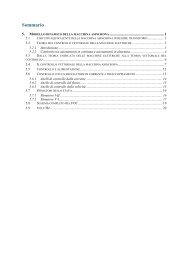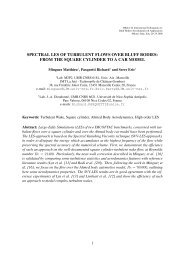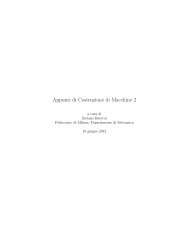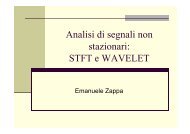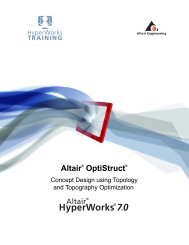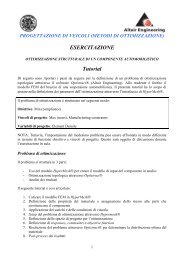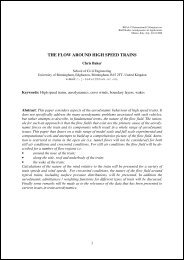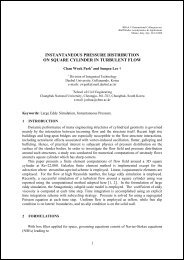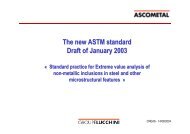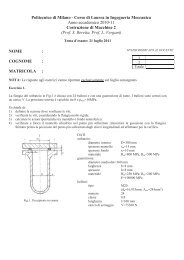Summary 2. The electromechanical energy conversion
Summary 2. The electromechanical energy conversion
Summary 2. The electromechanical energy conversion
You also want an ePaper? Increase the reach of your titles
YUMPU automatically turns print PDFs into web optimized ePapers that Google loves.
<strong>Summary</strong><br />
<strong>2.</strong> THE ELECTROMECHANICAL ENERGY CONVERSION .............................................................. 1<br />
<strong>2.</strong>1 THE PRIMITIVE MACHINE ............................................................................................................ 1<br />
<strong>2.</strong>1.1 <strong>The</strong> torque/speed curve ........................................................................................................... 2<br />
<strong>2.</strong>1.2 Reluctance torque and excitation torque ................................................................................ 3<br />
<strong>2.</strong>1.3 Motor nameplate and rated values ......................................................................................... 5<br />
<strong>2.</strong> <strong>The</strong> <strong>electromechanical</strong> <strong>energy</strong> <strong>conversion</strong><br />
<strong>2.</strong>1 <strong>The</strong> primitive machine<br />
Before addressing the study of electrical machines is convenient to introduce the study of the<br />
basic principles of <strong>electromechanical</strong> <strong>energy</strong> <strong>conversion</strong>.<br />
<strong>The</strong> starting point for understanding this theory is the primitive machine:<br />
I<br />
+ +<br />
l<br />
E<br />
v<br />
+<br />
B<br />
+<br />
V<br />
+ +<br />
F<br />
+ +<br />
M,R<br />
Figure 2-1: the primitive machine<br />
It is a device consisting of:<br />
• a straight conductor of length "l", mass "M" and resistance "R" free to move in horizontal<br />
direction<br />
• a uniform magnetic filed B perpendicular to the conductor rails plane (in the Figure 2-1 it is<br />
directed into the page).<br />
It follows that, if the conductor moves at a linear speed "v", an electromotive force is induced<br />
across an element "dl" of the conductor.<br />
dE = v × B ⋅ dl<br />
which, integrated over the length "l", in the case of Figure 2-1 becomes:<br />
E = Blv<br />
If it is carrying a current "I", the element "dl" is subjected to a force:<br />
dF = dl × B ⋅ I<br />
which, integrated over the length "l", in the case of Figure 2-1 becomes:<br />
F = BlI<br />
If the conductor moves and at the same time, current is flowing, the electric power transmitted<br />
equals the mechanical power:<br />
1
F<br />
P<br />
e<br />
= E ⋅ I = B ⋅l<br />
⋅ v ⋅ = F ⋅ v = P m<br />
B ⋅l<br />
Consider, then, the evolution of the following phenomenon (the conductor is free to move):<br />
• initial status: conductor is stopped and no current is flowing<br />
• a voltage V is applied, so an initial current begins to flow: I o<br />
= V / R<br />
• it generates an electromagnetic force on the conductor: Fe<br />
= B ⋅ l ⋅ I<br />
o<br />
• the conductor accelerates, and this generates an induced electromotive force: E = Blv<br />
V − E<br />
• in every instants you have, then, that the current becomes: I =<br />
R<br />
• equilibrium is reached when the current vanishes and therefore when V = E<br />
If braking forces go into action, then the balance is reached when F<br />
e<br />
= Fr<br />
and therefore the<br />
presence of a current is required. In particular:<br />
2 2<br />
V − E Blvo<br />
− Blv B l<br />
Fr<br />
= BlI = Bl = Bl = ⋅ ( vo<br />
− v)<br />
R R R<br />
Fr<br />
v = vo<br />
−<br />
2 2<br />
B l<br />
R<br />
where "v" is always less than the no load speed v o .<br />
What was said for for the primitive linear machine remains valid for a rotating machine, making<br />
the appropriate substitutions:<br />
• instead of the Bl product, the flux Ψ has to be considered<br />
• the electromagnetic force F e becomes electromagnetic torque T e<br />
• the linear speed v becomes angular speed Ω<br />
• the inertia force becomes inertia torque<br />
• the braking force becomes braking torque.<br />
<strong>The</strong> fundamental relationships then become:<br />
E = ΩΨ Te<br />
= ΨI<br />
EI = TeΩ<br />
We can thus obtain, in a similar way, the values of the operating speed:<br />
• at no load (without braking torque)<br />
V<br />
Ωo<br />
=<br />
Ψ<br />
• at a load (with braking torque)<br />
<strong>2.</strong>1.1 <strong>The</strong> torque/speed curve<br />
Ω = Ω<br />
−<br />
T r<br />
o 2<br />
Ψ<br />
<strong>The</strong> locus of the operation points (at steady state) of the electric machine is called torque/speed<br />
curve. <strong>The</strong> remarkable points are:<br />
• the intersection with the torque axis (zero speed = standstill), which represents the start<br />
torque.<br />
• the intersection with the speed axis (zero torque = no load), which provides no load speed.<br />
<strong>The</strong> intersection of this curve with the torque/speed curve of the mechanical load identifies the<br />
operating point.<br />
This operating point can be stable or unstable.<br />
R<br />
2
Will be stable if an increase of speed is a deficiency of torque so the machine slows down;<br />
conversely, a decrease of speed must be matched by a surplus of torque so the machine<br />
accelerates.<br />
Knowledge of the mechanical behavior of the load is a fundamental starting point for the drive<br />
design and for the choice of the machine to be used.<br />
By studying the behavior of the mechanical load, you can in fact identify the needs in terms of<br />
torque, starting from the time profile of the required speed. You may also obtain the points of<br />
maximum acceleration and deceleration, that are the points of maximum torque for the electric<br />
machine.<br />
<strong>2.</strong>1.2 Reluctance torque and excitation torque<br />
In this section we want to highlight the different contributions to the birth of electro-mechanical<br />
action.<br />
Basically there are two different cases:<br />
• torque resulting from the magnetic structure of the circuit, that is caused by anisotropy<br />
• resulting from the interaction between two magnetic coils.<br />
Consider the first case, referring to Figure 2-2, where you can highlight a magnetic structure<br />
made by a fixed part on which is mounted a winding and a rotating part.<br />
θ<br />
v<br />
i<br />
Figure 2-2: reluctance torque in a primitive machine<br />
From an electrical point of view, the system can be represented by a one-port as a series of a<br />
variable resistor with an inductance. Thus we have:<br />
d<br />
di dL<br />
v = Ri + ( Li)<br />
= Ri + L + i<br />
dt<br />
dt dt<br />
Multiplying both sides by he current "i", we obtain the equation expressing the <strong>energy</strong> balance:<br />
2 di 2 dL<br />
vi = Ri + iL + i<br />
dt dt<br />
Recalling that the instantaneous power absorbed by the magnetic field can be obtained by<br />
differentiating the <strong>energy</strong> expression, it results:<br />
dW d ⎛ 1 2 ⎞ di 1 2 dL<br />
pµ<br />
= = ⎜ Li ⎟ = Li + i<br />
dt dt ⎝ 2 ⎠ dt 2 dt<br />
3
Comparing this expression with the <strong>energy</strong> balance of the circuit, we find that the total electric<br />
power inlet (on the left of the equation) is divided into three contributions:<br />
• power dissipated in the resistance<br />
2<br />
p p<br />
= Ri<br />
• power related to the magnetic field<br />
• mechanical power<br />
p<br />
µ<br />
di 1 2<br />
= Li + i<br />
dt 2<br />
1 2 dL<br />
p m<br />
= i<br />
2 dt<br />
If we consider that the inductance in the reference frame varies with periodic sinusoidal pattern,<br />
you can highlight an expression for the anisotropy torque:<br />
1 2 dL 1 2 dL dθ<br />
1 2 dL<br />
p m<br />
= i = i = i Ω<br />
2 dt 2 dθ<br />
dt 2 dθ<br />
pm<br />
1 2 dL<br />
Tm<br />
= = i<br />
Ω 2 dθ<br />
Now, suppose you change the old structure so as to also include a winding on the rotating part as<br />
in Figure 2-3.<br />
dL<br />
dt<br />
θ<br />
i 2<br />
v 2<br />
v 1<br />
i 1<br />
Figure 2-3: reluctance and excitation torque in a primitive machine<br />
<strong>The</strong> equations describing this structure are that of a mutual inductor with variable parameters.<br />
You can then write:<br />
d d<br />
v1<br />
= R1i1<br />
+ ( L1i1<br />
) + ( Lmi2<br />
)<br />
dt dt<br />
d d<br />
v2<br />
= R2i2<br />
+ ( L2i2<br />
) + ( Lmi1<br />
)<br />
dt dt<br />
and developing the derivatives:<br />
di1<br />
dL1<br />
di2<br />
dLm<br />
v1<br />
= R1i1<br />
+ L1<br />
+ i1<br />
+ Lm<br />
+ i2<br />
dt dt dt dt<br />
di2<br />
dL2<br />
di1<br />
dLm<br />
v2<br />
= R2i2<br />
+ L2<br />
+ i2<br />
+ Lm<br />
+ i1<br />
dt dt dt dt<br />
4
If, therefore, similar to what we saw before, we extract the contributions related to the<br />
mechanical power, it is obtained:<br />
1 2 dL1<br />
1 dLm<br />
for the primary windings i1<br />
+ i1i2<br />
2 dt 2 dt<br />
1 2 dL2<br />
1 dLm<br />
for the secondary windings i2<br />
+ i1i2<br />
2 dt 2 dt<br />
In a similar way as before, we can highlight the following contributions to the torque:<br />
1 2 dL1<br />
1 2 dL2<br />
dLm<br />
Tm = i1<br />
+ i2<br />
+ i1i2<br />
2 dθ 2 dθ dθ<br />
where the first two terms are similar to the previous terms of anisotropy and the last torque is<br />
called excitation torque:<br />
dLm<br />
Tm = i1i2<br />
dθ<br />
<strong>2.</strong>1.3 Motor nameplate and rated values<br />
In order to be able to identify the characteristics of a machine is necessary to see the nameplate<br />
that is located on the frame. This nameplate is a real ID card that allows us to trace the basic<br />
features of the machine with regard to the application point of view. <strong>The</strong> values reported on the<br />
plate depend on the type of machine, but they are able to provide the information for a proper<br />
connection and use.<br />
As we shall see later, however, the data are not useful for determining the appropriate design of<br />
the control, given that certain parameters must be obtained experimentally and are rarely<br />
supplied by the manufacturer.<br />
<strong>The</strong> basic parameters set are called rated data and identify an operation point of the machine, at<br />
which the engine can work indefinitely in time without thermal problems (apart from obviously<br />
the wear).<br />
<strong>2.</strong>1.3.1 Nomenclature notes for rotating machinery<br />
• stator<br />
• rotor<br />
• inductor winding<br />
• induced winding<br />
part of the machine which remains stationary during operation<br />
part of the machine which is in rotary motion during operation<br />
winding that creates the main magnetic field<br />
winding immersed in the field created by the inductor<br />
5



